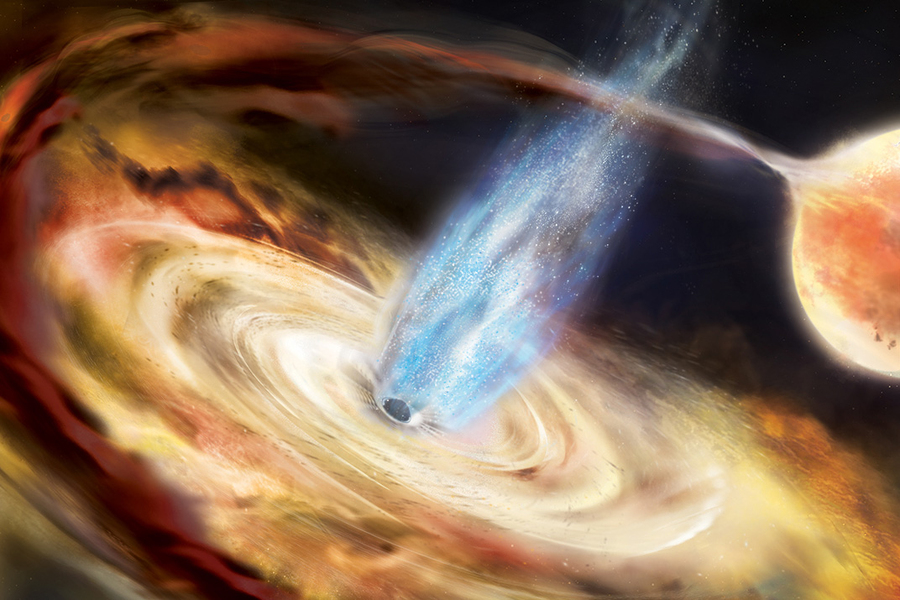
Black holes are the ultimate space-time sinks in the universe. Anything that wanders too close to one of these monsters gets sucked in, never to be seen again. That includes clouds of gas and dust from nearby stars. It all just disappears down the black hole’s insatiable maw. However, not all is lost. As the black hole feeds on the feast supplied by its neighbors, it gives off bright flashes of X-ray light. In a few places, the light bounces off the train of material spiraling into the black hole. That creates what astronomers call a black hole echo. Now, researchers have found eight of these systems relatively close to us in the Milky Way Galaxy.
We here on Earth are familiar with similar types of echoes. Motorists who get speeding tickets find out first-hand how police officers use radar echoes to measure a vehicle’s speed. In nature, bats emit high-pitch squeals that bounce off cave walls, trees, and houses. Echoes of its squeals give a bat a good idea of how far away obstacles are in its flight path.
In deep space, a black hole echo happens in x-ray binaries. These curious pairs contain a black hole and an orbiting star. The black hole, with its stronger gravitational pull, sucks gas and dust away from the star. That material spirals into the black hole and heats up. Eventually, this action creates an X-ray “squeal”. That flash of energetic light bounces off any nearby clouds of gas and dust. The “bounce” is a black hole echo. Astronomers use the echo to measure the distance between a black hole’s corona and its accretion disk (which contains the incoming material).
Finding Black Hole Echoes
At one time, these echoing systems were thought to be pretty rare. There are tens of millions of black holes in the Milky Way Galaxy. However, astronomers knew of only two black hole echo producers. That changed when a team at the Massachusetts Institute of Technology (MIT) used an automated research tool to find more of them. Dubbed the “Reverberation Machine”, it combed through vast amounts of data from NASA’s Neutron star Interior Composition Explorer (NICER). It looks for X-ray objects from aboard the International Space Station. The algorithm found 26 black hole X-ray binary pairs. Ten of those systems are relatively close to the solar system. Eight of those turned out to be black hole echo producers.
These X-ray flashes give astronomers a good look at the objects in the binaries. “The black holes range in mass from five to 15 times the mass of the Sun,” said MIT graduate student Jingyi Wang. He also noted that these binary systems all contain normal, low-mass stars like the Sun.
Erin Kara, assistant professor of physics at MIT, and co-author of a study published on May 2 in the Astrophysical Journal says these light echoes give important new information not just about the nearby environment, but about processes at the black holes themselves. “Now we’ve shown these echoes are commonly observed, and we’re able to probe connections between a black hole’s disk, jet, and corona in a new way,” she said in a press release.
The x-ray binary black hole echoes apparently come from action in the corona around the black hole. As the black hole feeds on incoming material, the corona seems to expand outward and upward as it belches out a final X-ray light flash. Then, everything dies down and the black hole goes quiet. The whole process repeats as material from the star spirals into the black hole for its next meal and X-ray flash.
Can These Echoes Explain Activity in Larger Black Holes?
Black hole echoes in nearby binaries have cosmic implications. They could give interesting clues to the behavior of their bigger siblings, the supermassive black holes. These are monsters in the hearts of galaxies and contain millions or billions of times the mass of the Sun. They, too, send huge high-speed jets of material out across millions of light-years of space. Could it be that they go through similar processes as their little siblings in the binary pairs?
“The role of black holes in galaxy evolution is an outstanding question in modern astrophysics,”said Kara. “Interestingly, these black hole binaries appear to be ‘mini’ supermassive black holes, and so by understanding the outbursts in these small, nearby systems, we can understand how similar outbursts in supermassive black holes affect the galaxies in which they reside.”
The research on these x-ray binary black hole echoes was supported in part by NASA. The research team includes Erin Kara, Jingyi Wang, Matteo Lucchini, Ron Remillard (all of MIT) and collaborators at Caltech and other institutions.
